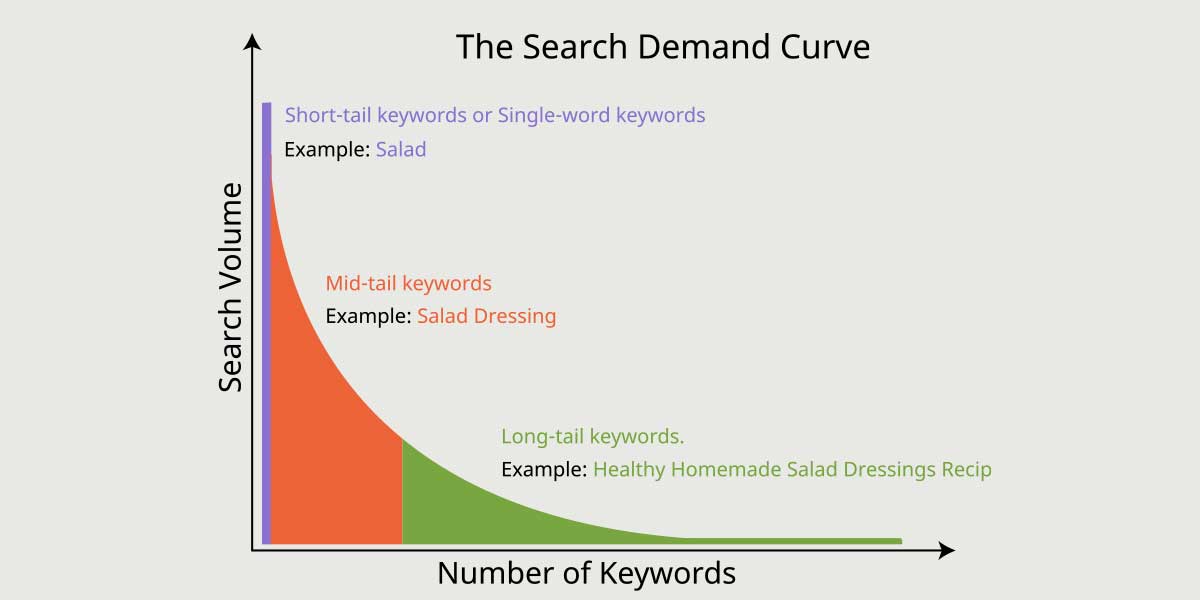Let's face it, the digital world is a jungle. And Google is the king of the beasts. To survive, you need more than just sharp claws; you need a cunning plan. That plan? Long-tail keywords.
What's a Long-Tail Keyword, Anyway?
Picture this: you're hungry. Do you search for "food"? Or do you search for "gluten-free vegan pizza near me"? The latter is a long-tail keyword. It's specific, detailed, and shows exactly what you want.
In the world of SEO, long-tail keywords are those sneaky little phrases that nobody else is paying attention to. They're the underdogs, the quiet achievers. But don't be fooled by their unassuming nature; they can be your ticket to Google Gold.
Why Long-Tail Keywords Are Your New BFF
- Less Competition: Everyone wants to rank for "shoes". But who's fighting over "comfortable red leather loafers for wide feet"? Exactly.
- Higher Conversion Rates: People searching for long-tail keywords are usually closer to buying. They know what they want.
- Better User Experience: When you target long-tail keywords, you create content that directly answers people's questions. This makes them happy, and happy users are loyal users.
- Improved SEO: Google loves relevant, high-quality content. Long-tail keywords help you create exactly that.

How to Find Your Perfect Long-Tail Keywords
Finding the perfect long-tail keyword is like finding a needle in a haystack but with better rewards. Here are a few tips:
- Use Keyword Research Tools: There are a lot of tools out there to help you find long-tail gold. Google Keyword Planner, SEMrush, and Ahrefs are just a few.
- Put Yourself in Your Customer's Shoes: What would you search for if you were looking for your product or service?
- Analyze Your Competitors: See what long-tail keywords they're ranking for.
- Leverage Autocomplete Suggestions: Google knows what people are searching for. Use its autocomplete suggestions to inspire your keyword ideas.
Creating Content That Converts
To harness the power of long-tail keywords, you need to create content that addresses these specific queries. Here’s a step-by-step guide to help you craft effective content around long-tail keywords:
- Keyword Research: Start with thorough keyword research. Tools like Google Keyword Planner, Ahrefs, and SEMrush can help you identify long-tail keywords relevant to your niche. Look for phrases with moderate search volume and low competition.
- Understand User Intent: Once you have your keywords, dig deeper into user intent. What are people looking for when they search for this phrase? Understanding the intent behind the search will guide your content creation, ensuring it meets the needs of your audience.
- Create In-depth Content: Long-tail keywords often signal that users are looking for detailed information. Create comprehensive, high-quality content that thoroughly addresses the topic. This could be in the form of blog posts, guides, tutorials, or reviews.
- Optimize On-page SEO: Incorporate your long-tail keywords naturally throughout your content. This includes the title, headings, meta descriptions, and body text. But remember, avoid keyword stuffing—Google’s algorithms are smart enough to penalize such practices.
- Use Related Keywords: Sprinkle related keywords and phrases throughout your content. This not only helps with SEO but also enriches the user experience by providing more value and context.
- Answer Related Questions: Incorporate a FAQ section or a dedicated segment to answer related questions. This not only targets more long-tail queries but also increases the likelihood of your content being featured in Google’s coveted “People Also Ask” boxes.
Tools to Aid Your Long-tail Keyword Strategy
Several tools can assist in identifying and leveraging long-tail keywords. Here are a few worth considering:
Google Keyword Planner: This tool provides insights into keyword search volumes and competition levels, helping you find profitable long-tail keywords.
Ahrefs: Ahrefs offers robust keyword research capabilities, including a Keywords Explorer tool that uncovers long-tail keywords related to your niche.
SEMrush: SEMrush is another powerful tool for keyword research, competitor analysis, and tracking your search rankings.
AnswerThePublic: This unique tool visualizes search queries related to your keyword, providing a wealth of long-tail keyword ideas based on actual user searches.
Ubersuggest: Ubersuggest, created by Neil Patel, is a user-friendly tool that offers keyword suggestions, search volume data, and competitive analysis.
Moz Keyword Explorer: Moz provides comprehensive keyword research and competitive analysis features, helping you identify valuable long-tail keywords.
Ahrefs reports that 96% of all queries are long-tail keywords, demonstrating the importance of understanding user query patterns.

Long-tail Keywords and Voice Search
As voice search becomes increasingly popular, long-tail keywords are gaining even more importance. Voice search queries tend to be longer and more conversational. For example, a user might type "best sushi restaurant on the Gold Coast" but ask their voice assistant, "What is the best sushi restaurant in Surfers Paradise?" By optimizing your content for these natural language queries, you can capture a growing segment of search traffic.
Many voice search queries come in the form of questions, which are perfect opportunities for long-tail keyword optimisation. To adapt to this trend, focus on creating content that answers specific questions and includes conversational phrases. Implementing a FAQ section that mirrors how people speak can also be beneficial.
Long-tail keywords also reflect specific user intent, and voice search often indicates that users know what they are looking for. This can be a game-changer for businesses, as targeting long-tail voice search queries allows them to reach users who are closer to making a purchasing decision or taking some action.
For instance, someone using voice search to say, "Where can I buy a blue wool sweater near me?" has a much clearer intent than someone who simply types "sweater." By targeting the long-tail keyword "buy blue wool sweater near [location]," businesses can position themselves to answer these precise queries and increase conversions.
Remember, the rise of smart speakers and voice-activated devices means users are searching in a more conversational tone, making long-tail keywords even more crucial.
Optimizing for Voice Search with Long-tail Keywords
Now that we understand the synergy between long-tail keywords and voice search, how can you tailor your content to capitalize on this opportunity? Here are some strategies:
1. Focus on Conversational Content
Voice search is conversational, so your content should be too. Instead of creating content stuffed with keywords, write in a more natural tone that mirrors the way people speak. Address specific user questions and provide direct, concise answers. Blog posts, FAQs, and how-to guides are excellent ways to incorporate conversational long-tail keywords into your content.
For instance, instead of a generic title like "Home Repair Services," consider a more specific and conversational approach: "What Are the Best Home Repair Services for Fixing a Leaky Roof?"
2. Use Question-based Keywords
Since voice searches are often questions, create content around these types of queries. Using tools like AnswerThePublic or People Also Ask sections in Google can help identify the common questions your audience is asking. Craft blog posts or FAQ sections that answer these specific questions, incorporating long-tail keywords in the process.
Examples of effective long-tail, question-based keywords include:
- "How do I improve my home’s energy efficiency?"
- "What are the best indoor plants for small apartments?"
3. Leverage Schema Markup
Schema markup is a powerful tool for enhancing the way search engines interpret and display your content, especially for voice search. By using structured data, you can provide more context to search engines about your content, improving your chances of appearing in featured snippets or position zero, which are often the source of voice search answers.
By marking up content that answers common questions with structured data, you're telling Google that your content is a good candidate to be featured as a voice search result.
4. Optimize for Local Voice Search
A significant portion of voice searches have local intent. People often ask voice assistants for information about local businesses or services (e.g., "Where’s the nearest coffee shop?" or "What time does the nearest pharmacy close?"). This makes local SEO and long-tail keywords incredibly important for voice search optimization.
Ensure your Google My Business listing is accurate and up-to-date, and target long-tail keywords that include local terms. For example:
- "best Italian restaurant in Brisbane"
- "affordable plumbers near me available 24/7"
5. Mobile Optimization is Key
Most voice searches are conducted on mobile devices, so your site needs to be mobile-friendly. Ensure your website loads quickly, is easy to navigate, and is optimized for a seamless mobile experience. If your site isn’t mobile-optimized, even the best long-tail keyword strategy won’t help you rank for voice search.
6. Provide Direct, Concise Answers
When optimising content for voice search, aim to provide concise, direct answers to users' questions. Voice assistants often pull answers from featured snippets, which typically highlight the most relevant, succinct information. By crafting content that answers specific long-tail keyword queries in under 30 words, you increase your chances of being featured as the voice search result.
7. Include Conversational Phrases in Your Content
Think about how people might phrase queries when using voice search. Including conversational phrases in your content helps to match the natural language patterns of voice searches. For example:
- "What’s the best way to lose weight after pregnancy?"
- "How much does it cost to hire a professional dog trainer?"
By optimising content to reflect these natural speech patterns, you increase the likelihood of ranking for voice search queries.
By focusing on conversational, specific, and user-intent-driven queries, businesses can enhance their visibility and capture a growing segment of search traffic that relies on voice-enabled devices. Voice search isn’t just the future—it’s already here, and long-tail keywords are the key to unlocking its full potential.

What are long-tail keywords in Google Ads?
Long-tail keywords in Google Ads are more specific, multi-word phrases that people search for when they're close to making a purchase. They're often more targeted than shorter, more general keywords, which can lead to higher conversion rates and lower costs per click.
Characteristics of Long-Tail Keywords in Google Ads
- More Specific: Long-tail keywords are longer phrases (typically 3+ words) that reflect a more specific search query. For example, instead of targeting a broad keyword like “shoes,” a long-tail keyword might be “affordable running shoes for men.”
- Lower Competition: Since long-tail keywords are more specific, fewer advertisers bid on them. This results in lower competition compared to short, popular keywords, often leading to lower cost-per-click (CPC).
- Higher Relevance: These keywords are often used by searchers who know exactly what they’re looking for. Targeting long-tail keywords helps you reach a more focused and relevant audience. For example, someone searching for "buy waterproof hiking boots size 10" is more likely to purchase than someone simply searching for "hiking boots."
- Higher Conversion Rates: Because long-tail keywords attract users with clear intent, they often lead to higher conversion rates. These users are typically further along in the buying process and more likely to take the desired action, such as making a purchase or signing up for a service.
Benefits of Using Long-Tail Keywords in Google Ads
- Cost-Effective Bidding: Long-tail keywords tend to have lower CPCs, allowing advertisers to maximize their budget. You can bid less on these keywords while still driving relevant traffic.
- Improved Quality Score: By targeting more specific and relevant keywords, your ads are more likely to match user intent, which can improve your Quality Score—a critical factor in determining ad rank and CPC.
- Targeted Audience: Since long-tail keywords are more descriptive, you can fine-tune your campaigns to match the exact needs of your potential customers, reducing wasted clicks and irrelevant traffic.
- Less Competition: Bidding on broader keywords often pits you against big brands or companies with larger ad budgets. By focusing on long-tail keywords, you face less competition, making it easier for your ads to appear in top positions.
How to Use Long-Tail Keywords in Google Ads Campaigns
Keyword Research: Use tools like the Google Ads Keyword Planner to discover long-tail keywords that are relevant to your business. You can also leverage tools like Ubersuggest or AnswerThePublic to find longer phrases your audience is searching for.
Ad Copy Optimization: Incorporate your long-tail keywords naturally into your ad copy. Tailoring your ad text to match specific searches can improve your ad relevance and click-through rates (CTR).
Targeting Options: In AdWords, you can use phrase match or exact match targeting for long-tail keywords to ensure your ads are triggered by search queries that closely match your chosen keywords. This increases relevance and helps you avoid wasting ad spend on unrelated searches.
Negative Keywords: To refine your targeting even further, use negative keywords to exclude searches that may seem similar but are irrelevant. This ensures you’re only bidding on keywords that align with your goals.

Measuring Your Long-Tail Success
You can't improve what you can't measure. To ensure your long-tail keyword strategy is working, it's essential to track your progress. Here are some key metrics to monitor:
Organic Traffic: Use Google Analytics to track changes in your organic traffic. Look for increases in visitors coming from search engines.
Keyword Rankings: Tools like Ahrefs, SEMrush, and Moz can help you monitor your keyword rankings over time. Pay attention to how your long-tail keywords are performing.
Conversion Rates: Ultimately, the goal of attracting more traffic is to increase conversions. Track metrics such as sales, sign-ups, or other desired actions to measure the effectiveness of your content.
Engagement Metrics: Monitor engagement metrics like bounce rate, average session duration, and pages per session. High engagement indicates that your content is resonating with your audience.
Backlinks: Track the number and quality of backlinks your content is attracting. High-quality content optimized for long-tail keywords can naturally attract more backlinks, which in turn boosts your SEO.
User Feedback: Collect feedback from your audience through comments, surveys, or direct inquiries. Understanding how users interact with your content can provide valuable insights for further optimization.
Future Trends: The Evolving Landscape of Long-tail Keywords
The digital landscape is constantly evolving, and staying ahead of trends is crucial for maintaining your SEO edge. Here are a few future trends to watch out for:
Voice Search Optimisation: As previously mentioned, the rise of voice search is transforming how users interact with search engines. Optimizing for natural language and long-tail keywords will become even more critical.
AI and Machine Learning: Advances in AI and machine learning are making search engines smarter. Google’s algorithms are becoming better at understanding context and user intent, which means content quality and relevance will be more important than ever.
Mobile-first Indexing: With Google’s mobile-first indexing, ensuring your website is mobile-friendly is essential. Long-tail keyword optimization should extend to mobile users, who often use different search phrases compared to desktop users.
Visual and Video Search: The increasing popularity of visual and video search means optimizing your visual content for long-tail keywords can give you a competitive advantage. Use descriptive, keyword-rich file names, alt text, and captions for images and videos.
Localised Search: As search engines become more sophisticated, local search optimization is gaining prominence. Long-tail keywords with a local focus, such as "best vegan restaurants in Portland," can help attract nearby customers and improve local search rankings.

Long-Tail Keywords: The Bottom Line
Long-tail keywords are the unsung heroes of SEO. They might not be as glamorous as their short-tail counterparts, but they're definitely more effective. By focusing on long-tail keywords, you can improve your search rankings, attract more targeted traffic, and boost your bottom line.
Remember, the key to unlocking the power of long-tail keywords lies in understanding your audience, conducting thorough keyword research, and crafting high-quality content that meets the specific needs of your users. As the ability. to do business online continues to evolve, staying adaptable and ahead of trends will ensure your long-tail keyword strategy remains effective and impactful.
So, what are you waiting for? Start digging for long-tail gold today! Your website will thank you for it.
Ready to ditch the short-tail blues and embrace the long-tail life? Let's chat!








![How to Use Google Keyword Planner [2024 Guide]](https://seoplans.net.au/images/blog-images/how-to-use-keyword-planner2.jpg)

